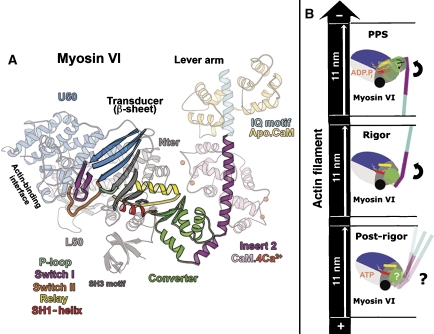Figure 1.
Important features of the myosin VI motor. (A) The different elements of the myosin VI motor are shown in the rigor-like myosin VI structure (Ménétrey et al, 2005). The motor domain is composed of four subdomains (Nter, U50, L50 and the converter). The converter (green) is the most mobile of these and is directly linked to the lever arm. In myosin VI, the converter interacts with a unique inserted structural element (insert 2; purple). This redirects the lever arm in the opposite direction from plus-end myosins. The central beta-sheet (gray and blue) is the major component of the transducer, which can adopt differently twisted conformations depending on the nucleotide- and actin-binding states of the motor. There are three nucleotide-binding elements: P-loop, switch I and switch II. Rotation of the converter is controlled by the rearrangements of the relay (yellow) and the SH1-helix (red). (B) Diagram illustrating the converter (green) and the lever arm (purple for the insert 2-CaM-binding region and cyan for the IQ-CaM) position in three states of the myosin VI motor cycle. The motor domain is composed of an SH3 domain (black ball) and four subdomains (N-terminal (Nter, gray), upper 50 kDa (U50, blue), lower 50 kDa (L50, light gray) and converter). The relay (yellow) and SH1-helix (red) are two connectors of the motor that direct the rotation of the converter. The powerstroke corresponds to the large (11 nm) movement of the lever arm between the pre-powerstroke (PPS, 2V26) and rigor state (2BKH), during which the converter both rotates and alters its conformation. ATP binding in the rigor state induces rearrangements in the motor to detach the motor from actin and produce the post-rigor state. To optimize the powerstroke, no reversal of the lever arm movement should occur upon ATP binding and myosin detachment from actin. However, it is not clear that this can be accomplished for myosin VI, since it is unclear what happens to the converter conformation and lever arm position following ATP binding.

